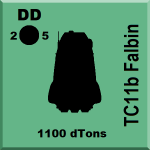TC11 Falbin class Destroyer
| TC11 Falbin class Destroyer | |
|---|---|
 Trooles Confederation vessel. | |
| Type: DD Destroyer | |
| Category | ACS |
| Size | 1,100 Tons |
| Hull Configuration | Cone Hull |
| Streamlining | Streamlined Hull |
| Tech Level | TL–11 |
| Engineering | |
| Computer | 1x Model/5 Fib |
| Jump | J-2 |
| Maneuver | 5 G |
| Armaments | |
| Hardpoints | 11 |
| Accommodations | |
| Staterooms | 27 |
| Personnel | |
| Crew | 48 |
| Officers | 8 |
| Enlisted | 16 |
| Marines | 24 |
| High/Mid Passengers | 0 |
| Payload | |
| Cargo | 5 Tons |
| Fuel tank | 286 Tons |
| Construction | |
| Origin | Trooles Confederation |
| Year Operational | Unknown |
| End of Service | Still in active service. |
| Price | |
| Cost | MCr1,183.643 (base) MCr946.915 (qty) |
| Architect fee | MCrRonald B. Kline, Jr. |
| Statistics | |
| Quick Ship Profile | DD-BS52 |
| Images | |
| Blueprint | No |
| Illustration | Yes |
| Source | |
| Also see | Escort |
| Canon | Published, fan design |
| Era | 1105 |
| Starships are designed with the Classic Traveller format, using High Guard Shipyard v1.13 written by Andrea Vallance. | |
The TC11 Falbin class Destroyer is a warship.
- It is a military ship and a Destroyer.
- Its full designation is the TC11b Falbin class.
Description (Specifications)[edit]
The Falbin class is a combat vessel of the Trooles Confederation.
- The class is operated by the Trooles Confederation Navy.
- The vessel is locally designed.
- It is typically crewed by humans.
- It is a TL–11 design.
Image Repository[edit]
General Description[edit]
The Falbin class is a destroyer deployed by the Trooles Confederation. Examples of the class can be encountered throughout the coreward parts of Theta Borealis Sector. The vessel has a fully streamlined conical structure hull. It is fitted with fuel scoops and fuel purification plant allowing it to perform wilderness ocean refueling.
Basic Ship Characteristics[edit]
Following the Imperial Navy and IISS Universal Ship Profile and data, additional information is presented in the format shown here. The small craft factor indicates the number of squadrons (of ten craft) carried on the ship. Tonnage on the universal ship profile is shown in kilotons (thousands of tons) where necessary. [1]
| No. | Category | Remarks |
|---|---|---|
| 1. | Tonnage | The Falbin class destroyer is constructed using a 1,100 Ton hull built in a fully streamlined conical structure configuration. The hull is capable of wilderness ocean refueling.
|
| 2. | Crew | x48 personnel.
Accommodations
Accessible areas of the hull are fitted with grav plates and inertial compensators and have full life support and environmental systems.
|
| 3. | Performance | The vessel mounts a Jump-2 drive, a Maneuver-5 drive, and an upgraded fusion Power Plant-6, giving performance of Jump-2 and 5-G acceleration. The ship has an agility rating of 5 and an emergency agility of 5. The internal fuel tankage is sufficient for a Jump-2 and gives the power plant 4 weeks duration. It is fitted with drop tanks, should extended range operations be required.
|
| 4. | Electronics | Adjacent to the bridge are a pair of Model/5 fib computers.
|
| 5. | Hardpoints | x11 hardpoints.
|
| 6. | Armament | The Falbin class are fitted with weapon systems for naval service.
|
| 7. | Defenses | Factor-3 hull armor |
| 8. | Craft | x4 4T Grav APCs |
| 9. | Fuel Treatment | The vessel has internal fuel tankage of 286 Tons. They are delivered with a new set of optional jump 2 drop tanks, which can be fitted as needed.
|
| 10. | Cost | The basic cost of the vessel is MCr1,183.643 (base) MCr946.915 (qty)
|
| 11. | Construction Time | 132 weeks as standard, 106 weeks in bulk.
|
| 12. | Comments | Standard cargo capacity amounts to 5.0 Tons.
|
History & Background (Dossier)[edit]
The TC11 Falbin class Destroyer class is used by the Trooles Confederation. These fully streamlined conical structures can land on planetary surfaces. This class is characterized by less acceleration and more armor. They have two computers which expands their ECM abilities. The marines lost their dropships and must rely on a platoon of four Grav APCs. Originally a security specialist was part of the crew, the admiralty realized this was redundant with the 24 marines embarked and removed that billet, for a savings in cost and a slight expansion in cargo capacity. Common to all the destroyers in this series, they lack some jump range with only enough internal fuel for a single Jump-2. The additional armor pushed the price per unit above the larger TC12 Ivorholm class Destroyers. The rationale for the smaller maneuver drives was that the power plant couldn't provide enough power for the evasive abilities, therefore the extra acceleration was wasted. Several captains feel this was foolish, to lower the acceleration of a pursuit vessel.
Class Naming Practice/s:
Vessels of the Trooles Confederation are given alphanumeric designations and callsigns by other interstellar states. TC refers to Trooles Confederation (a designation applied to all Confederation combat units), 11 is a multiple of hundreds of tons of displacement and also indicates at a glance the number of weapons mounts, and when it is used 'b' refers to the version of the vessel, relating to its construction tech level and bracketing its maximum jump potential. Type codes will often repeat: 'Falbin' is an easy to remember class name to identify the specific type of vessel.
- Individual vessels are named by a committee using an authorized list.
Selected Variant Types & Classes[edit]
Military Ship - Warship- Very Light Destroyer:
- Type DVL class Very Light Destroyer
- Auldwich class Light Destroyer
- Goblin class Destroyer
- Grom class Destroyer
- Heng-O class Small Escort
- KE12 Sarash class Destroyer
- Lomba class Light Destroyer
- Moisura class Destroyer
- Muavenet class Destroyer
- Nemesis class Destroyer
- Gearing class Destroyer
- Sampson class Destroyer
- Satvet class Destroyer
- Sha'a class Destroyer
- TC11 Falbin class Destroyer
- TC12 Ivorholm class Destroyer
- TC13 Falcon class Destroyer
- Tembo class Destroyer
References & Contributors (Sources)[edit]
| This article has metadata. |
| This article is missing content for one or more detailed sections. Additional details are required to complete the article. You can help the Traveller Wiki by expanding it. |
- Marc Miller, Frank Chadwick, John Harshman. High Guard (Game Designers Workshop, 1980), 20-37. (Design Sequence Used)
- Traveller Wiki Editorial Team
- Author & Contributor: Lord (Marquis), Captain, and Lead Naval Architect Ronald B. Kline, Jr. of the Imperial Navy
- Author & Contributor: Lord (Marquis) and Master Scout Emeritus Adie Alegoric Stewart of the IISS
- Author & Contributor: Lord (Marquis) and Master of Sophontology Maksim-Smelchak of the Ministry of Science
- ↑ Timothy B. Brown. Fighting Ships (Game Designers Workshop, 1981), 10.
- ↑ Timothy B. Brown. Fighting Ships (Game Designers Workshop, 1981), 10.
